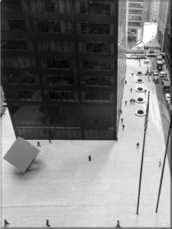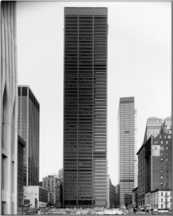|
The 1961 Zoning Law
The first finite limits on the height and bulk of commercial buildings were imposed by the 1961 zoning resolution. A sweeping revision of the 1916 law, it eliminated the open-ended provision for unrestricted height over one quarter of the lot and established the principle of FAR, or Floor Area Ratio, which keyed the maximum floor space permitted in a building to a multiple of the area of the lot. It also created "incentive zoning," which traded bonus stories in the sky for public amenities such as plazas, arcades, and subway entrances.
|

By increasing the allowable area for a sheer tower from twenty-five to forty percent of the lot, the 1961 code encouraged the modernist paradigm of the tower in the plaza that had been so widely applauded at 1 Chase Manhattan Plaza and the Seagram Building in midtown. The urbanistic effects of the new open space were powerfully demonstrated in Lower Manhattan with the three interconnecting plazas of Chase, Marine Midland, and Liberty Plaza and, less successfully, in the pedestrian paths along Water Street. | ||
|
| > | ||
